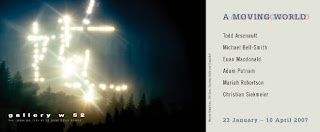
A Moving World
Todd Arsenault
Michael Bell-Smith
Euan Macdonald
Mariah Robertson
Christian Siekmeier
In the mid 1960s, the Sony Corporation introduced the first portable video device, a large black-and-white camera connected to a half-inch reel-to-reel recorder. Before the bulky but mobile “Portapak,” the only consumer-grade moving image technology available were amateur film cameras, the eight and sixteen-millimeter formats lacking the instant playback aspects of video. South Korean-born artist Nam June Paik supposedly turned one of the earliest Portapaks on a papal motorcade making its way down Fifth Avenue. The tapes, shot from inside a taxicab, were shown later that night. So, the apocryphal story would have it, video art was born.
Even if obscuring lesser-known figures, this origin myth conveys a defining point: the transformation of the nascent technology into an art form. Video quickly became an accessible artistic tool, a democratic extension of corporate-run television that enabled artists to address the relationship between technology, mass media, and culture. Part of its agency lay in being anti-Establishment, seemingly outside the institutions of art and free of the co-optive character of broadcast media. Video offered a critique of commodified culture—freed from the status of an art object by its reproducibility—and the heterogeneity afforded by a largely undefined medium.....“A Moving World,” shows the medium seamlessly intertwined with photography, painting and sculptural practice. And as with any medium in which technological changes become defining artistic ones, the antecedents of today’s video art—the grainy, muffled tapes often shot in real time—have given way to a refined combination of video, cinema, and new media.
From my exhibition essay for A Moving World, curated by Dinaburg Arts and opening this Wednesday, January 31st, 6-8pm, at Gallery W52, 31 West 52nd.

